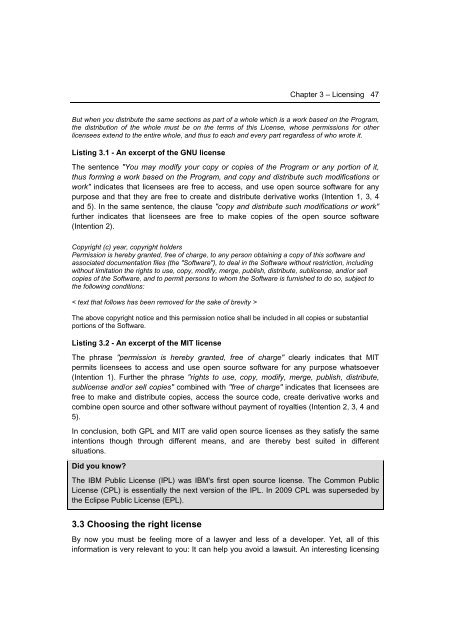Getting Started with Open Source Development
Create successful ePaper yourself
Turn your PDF publications into a flip-book with our unique Google optimized e-Paper software.
Chapter 3 – Licensing 47<br />
But when you distribute the same sections as part of a whole which is a work based on the Program,<br />
the distribution of the whole must be on the terms of this License, whose permissions for other<br />
licensees extend to the entire whole, and thus to each and every part regardless of who wrote it.<br />
Listing 3.1 - An excerpt of the GNU license<br />
The sentence "You may modify your copy or copies of the Program or any portion of it,<br />
thus forming a work based on the Program, and copy and distribute such modifications or<br />
work" indicates that licensees are free to access, and use open source software for any<br />
purpose and that they are free to create and distribute derivative works (Intention 1, 3, 4<br />
and 5). In the same sentence, the clause "copy and distribute such modifications or work"<br />
further indicates that licensees are free to make copies of the open source software<br />
(Intention 2).<br />
Copyright (c) year, copyright holders<br />
Permission is hereby granted, free of charge, to any person obtaining a copy of this software and<br />
associated documentation files (the "Software"), to deal in the Software <strong>with</strong>out restriction, including<br />
<strong>with</strong>out limitation the rights to use, copy, modify, merge, publish, distribute, sublicense, and/or sell<br />
copies of the Software, and to permit persons to whom the Software is furnished to do so, subject to<br />
the following conditions:<br />
< text that follows has been removed for the sake of brevity ><br />
The above copyright notice and this permission notice shall be included in all copies or substantial<br />
portions of the Software.<br />
Listing 3.2 - An excerpt of the MIT license<br />
The phrase "permission is hereby granted, free of charge" clearly indicates that MIT<br />
permits licensees to access and use open source software for any purpose whatsoever<br />
(Intention 1). Further the phrase "rights to use, copy, modify, merge, publish, distribute,<br />
sublicense and/or sell copies" combined <strong>with</strong> "free of charge" indicates that licensees are<br />
free to make and distribute copies, access the source code, create derivative works and<br />
combine open source and other software <strong>with</strong>out payment of royalties (Intention 2, 3, 4 and<br />
5).<br />
In conclusion, both GPL and MIT are valid open source licenses as they satisfy the same<br />
intentions though through different means, and are thereby best suited in different<br />
situations.<br />
Did you know?<br />
The IBM Public License (IPL) was IBM's first open source license. The Common Public<br />
License (CPL) is essentially the next version of the IPL. In 2009 CPL was superseded by<br />
the Eclipse Public License (EPL).<br />
3.3 Choosing the right license<br />
By now you must be feeling more of a lawyer and less of a developer. Yet, all of this<br />
information is very relevant to you: It can help you avoid a lawsuit. An interesting licensing

















